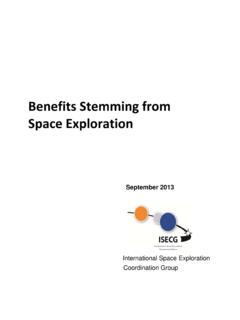Transcription of Graphite-Based Bipolar Plates for PEM Motive Fuel Cell ...
1 1 graphite - based Bipolar Plates for PEM Motive fuel Cell Applications Julian NorleyFellow of the American Carbon Society Vice President Innovation & Technology advanced Energy Technologies LLC DOE Bipolar Plates Workshop Feb 14th20172 Outline Introduction to advanced Energy Technologies LLC Review of Carbon & graphite Bipolar plate Technologies Expanded/Flexible graphite Materials Molded/Filled/Particulate/Composite graphite Materials Carbon & graphite Coated Metallic Plates R&D Needs Simon Farrington (AFCC) will talk later on forming and manufacturing issues in automotive Bipolar plate production 3 advanced Energy Technologies LLC (AET) A subsidiary of GrafTech International 100 year + company headquartered in Cleveland, Ohio Manufacturer of flexible graphite materials for electronic thermal management, fluid sealing, automotive gasket.
2 Fire retardant and fuel cell applications & module photos courtesy of Ballard Power 4 Outline Introduction to advanced Energy Technology Review of Carbon & graphite Bipolar plate Technologies Expanded/Flexible graphite Materials Molded/Filled/Particulate/Composite graphite Materials Carbon & graphite Coated Metallic Plates R&D Needs5 Expanded/Flexible graphite Materials Expanded graphite materials are derived from naturally occurring flake graphite The flake is chemically intercalated and then heated to expand the graphite The expanded graphite is then gradually compressed into a mat form The mat blank is then compression molded into a half- plate comprising gas and coolant channels The graphite preform is then impregnated with resin and cured to form the finished half- plate fuel and oxidant half- Plates are adhesively bonded and cured to form the finished Bipolar plate Bipolar plate /minimum web thickness ~ mm current field use ~ mm GrafTech/Ballard DOE project ~ mm State-of the Art More complex flow field designs possible vs corrugated metal Plates US Patent 3,404,061 al.
3 , Oct 1 1968 ManufactureScreen shot courtesy of Ballard Power mm6 Expanded/Flexible graphite Materials Expanded graphite materials retain the anisotropic structure of the starting flake with the result that in-plane (xy) and through thickness (z) properties are very different Expanded graphite materials comprise a continuous graphite phase with resultant higher in-plane thermal & electrical conductivity than bulk molded compounds but lower through plane properties Higher thermal conductivity exploited in higher current density designs Lower density than steel and do not corrode Lower strength and electrical conductivity than steelProperties PropertyExpanded GraphiteBulk Molded Compound(BMC 940) Stainless Steel 316L (coated for corrosion results)2020 DOE Target or Target impactedDensity Weight < kg/kWnetThermal Conductivity W/mK280(xy) 5 (z) 1315n/aElectrical ConductivityS/cm1100 (xy) 20 (z) 70 (xy)30 (z) 13500> 100 S/cmCTE ( m) (x,y) 90(z)3016n/aTensile/FlexuralStrength (MPa)40/6028/38 NA/480 Flex > 34 (carbon plate ) Corrosion A/cm2 NoneNone< < 1 Cross section of compressed expanded graphite sheetCross section of typical bulk molding compound7 Expanded/Flexible graphite Materials Ballard s Mark 900 series liquid-cooled fuel cell stack introduced in January 2000 was the first to use resin impregnated expanded graphite for on-road vehicles 2000-2006 Used in early generation automotive prototypes (Daimler-Chrysler NECAR MercedezBenz A-Class, Ford Focus, Honda FCX, and bus programs (Daimler Chrysler Citaro))
4 Introduced into fork lift applications in 2005 with General Hydrogen. > 13,000 Plug Power GenDrive vehicles now in service Used in current generation FCveloCity modules for bus applications > 1,000,000 Bipolar Plates produced Have accumulated : >10 million km of road service in bus and automotive applications Millions of hours of run time in fork lift applications History of Field Performance Field Information and photos courtesy of Ballard Power & Plug Power 8 Outline Introduction to advanced Energy Technology Review of Carbon & graphite Bipolar plate Technologies Expanded/Flexible graphite Materials Molded/Filled/Particulate/Composite graphite Materials Carbon & graphite Coated Metallic Plates R&D Needs9 Molded/Filled/Particulate graphite Composite Materials Use bulk-molding compounds that comprise high fraction loadings (77-87 wt%) of natural and synthetic graphite particulates (d50 ~ 30-60 m)
5 And carbon fibers in thermoset resins typically epoxy/vinyl-ester/phenolic/bismaleimider esins Plates are typically compression molded with typical times of ~ 1-5 minutes at temperatures of 150-180 C at 20-50 MPa Multiple suppliers of bulk molding compounds and finished Plates Similar Bipolar plate /web thicknesses to expanded graphite materials ~ mm current field use ~ mm State-of the Art Have been used successfully in Motive applications since 2005 and favored for thicker Plates /stationary power applications Manufacture, Properties & Field Performance Screen shot courtesy of Ballard PowerSource:-Nisshinbo website Source:-Composites World/BMCI 10 Outline Introduction to advanced Energy Technology Review of Carbon & graphite Bipolar plate Technologies Expanded/Flexible graphite Materials Molded/Filled/Particulate/Composite graphite Materials Carbon & graphite Coated Metallic Plates R&D Needs11 Carbon & graphite Coated Metallic Plates Argonne National Lab has reported work (Project ID #FC024) on composite fluoropolymer/ graphite coatings on aluminum Bipolar Plates Orion panels show no corrosion; a single cell stack was tested with improved performance vs uncoated aluminum Chung et al and Fukutsukaet al.
6 Both utilized carbon-coated 304SS in single and three-cell PEM fuel cells respectively CVD carbon film on Ni-coated 304 SS Plates demonstrated chemical stabilities comparable to Pocographite Plasma assisted CVD carbon film on 304SS exhibited higher electrical conductivity than uncoated material while maintaining an acceptable level of corrosion resistance Both studies were relatively short term so further study required Manufacture & Properties 12 Outline Introduction to advanced Energy Technology Review of Carbon & graphite Bipolar plate Technologies Expanded/Flexible graphite Materials Molded/Filled/Particulate/Composite graphite Materials Carbon & graphite Coated Metallic Plates R&D Needs13R&D Needs For expanded flexible graphite materials, the recommended main focus area needs to be high speed forming, sealing, curing, gluing & cutting operations to meet the automotive volume and cost targets Per DE-FC36-07GO17012 Roller Embossing & Adiabatic Forming have been identified as candidate high speed forming routes to 100k-500k stacks/yr Some encouraging R&D/pilot scale scoping work performed on roller embossing & adiabatic forming Roller embossingdemonstrated at 9 meters/min by Terrella Energy translates into 1 plate /3 seconds.
7 Very high density graphite parts demonstrated which reduces resin content facilitating sealing vs impregnation approach, faster curing, enabling a continuous operation Adiabatic forming -Double sided 160 cm2 test half- plate formed in < s using high velocity impact unit. Improved material flow and feature definition. Less energy than identical metal part. Need to update cost analysis to incorporate these new manufacturing scenarios For particulate graphite materials we are suggesting a similar focus on high speed forming and property improvements for high current density (particularly thermal) Focus on High Speed Forming Double sided 160 cm2 test plate produced by adiabatic forming (< ) 14 Summary Expanded flexible graphite Plates have been used successfully in full-scale Motive applications for > 15 years with >10 million km of road service in bus and automotive applications and millions of hours of run time in fork lift applications.
8 Recent high-speed forming work, particularly roller embossing, has demonstrated a path to automotive scale cost and volumes at the current densities required by the industry. This is a recommended area for additional R&D Filled/particulate/molded graphite composite Plates have been used successfully in full-scale Motive applications for > 10 years. R&D needs identified include a focus on high speed forming methods and property improvements (particularly thermal) 15 Acknowledgements The presenter would like to acknowledge the assistance of the following individuals in preparing the presentation Warren Williams & Bevan Moss Ballard Simon Farrington of AFCC John Kenna of Terrella Energy Dave Stuart, Ryan Wayne and Matt Getz and of advanced Energy Technologies LLC. 16 References Next Generation BiPolarPlates for Automotive PEM fuel cells , GrafTech International, DE-FC36-07GO17012, Project Period March 1 2007 to September 30, 2009 United States Patent Application US 2007/0111078 A1, May 17 2007 Nisshinbo Industries Typical Data BMC 940 Vinyl Ester BiPolarPlate Material BMC inc A review of Metallic BiPolarPlates for Proton Exchange Membrane fuel cells ; Materials & Fabrication Methods, Karimiet al.
9 , Advances in Materials Science and Engineering Volume 2012 (2012), Article ID 828070 Metallic Bipolar Plates with Composite Coatings , Mawdsleyet al. Argonne National Laboratory Project ID # FC024, May 11, 2011 17 Appendix Slides DOE Bipolar plate Targets 18 DOE Bipolar plate Targets












